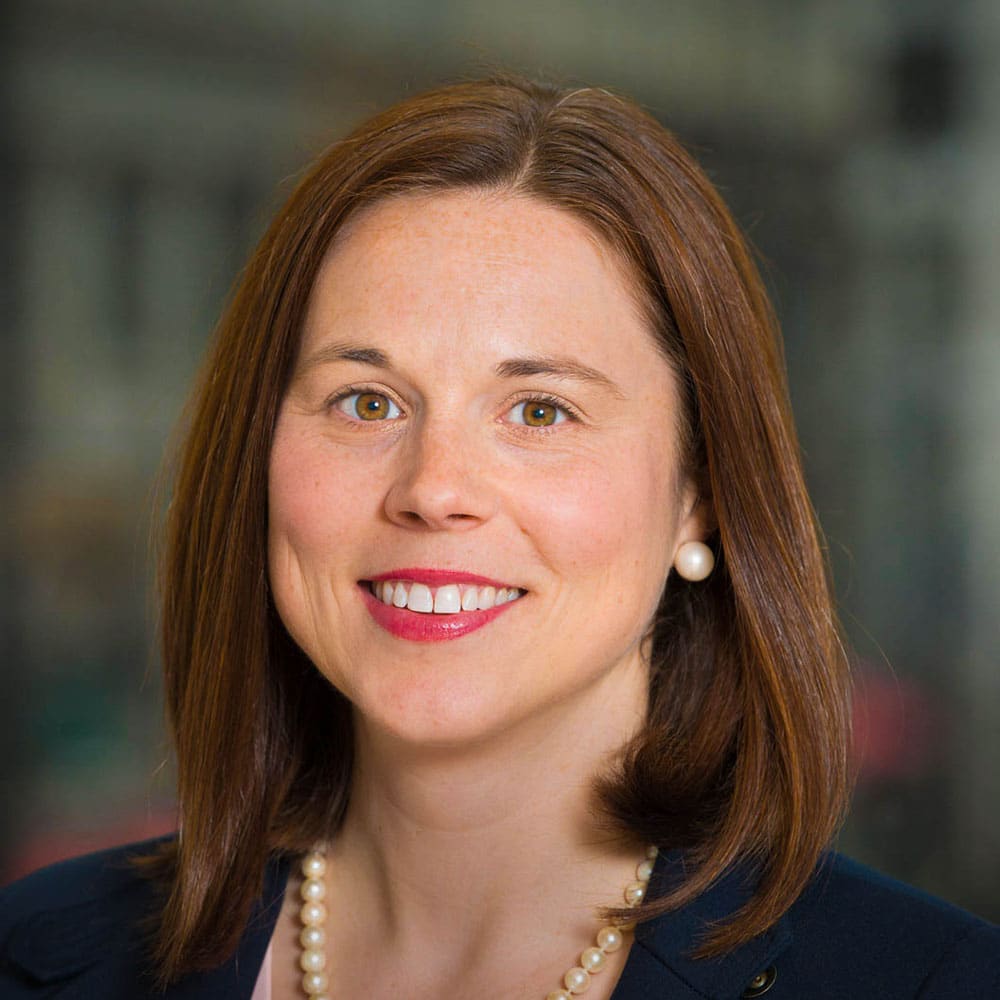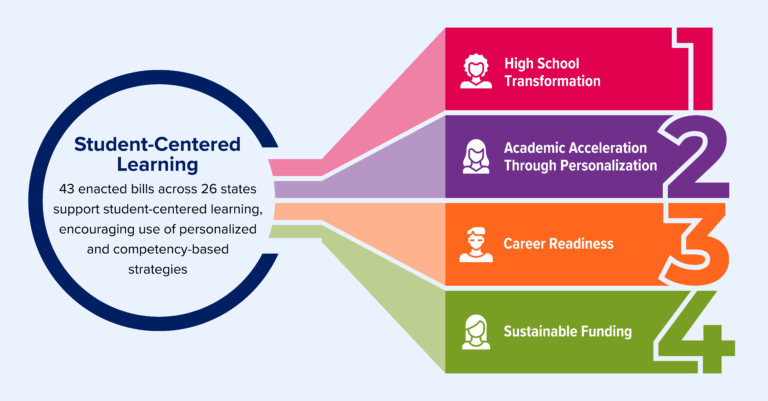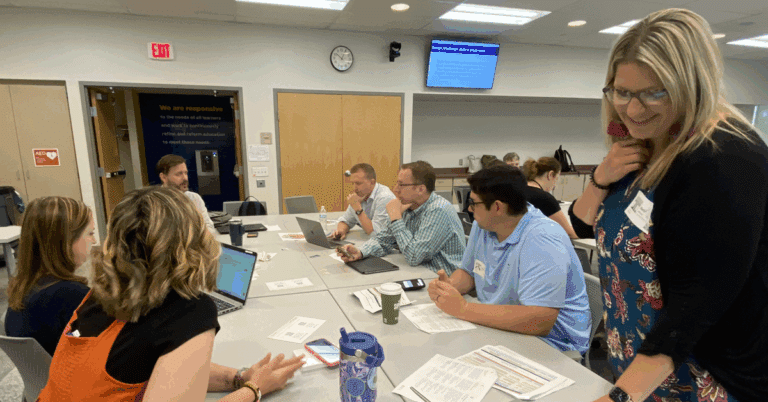Since its founding, KnowledgeWorks has been at the forefront of high school transformation.
For more than a decade, we’ve championed personalized, student-centered learning as key to rethinking the high school experience to better prepare young people for a rapidly changing world. With the release of the third edition of our State Policy Framework for Personalized Learning, we’re once again offering states a roadmap to reimagine the high school experience.
Despite decades of federal and state education reforms, too many high school graduates remain underprepared for life beyond K-12 education. The traditional high school model, defined by age-based grade levels, seat time and traditional credits, doesn’t reflect what we know about how students learn. This structure prioritizes compliance over curiosity and tests over transferable skills. High remediation rates, persistent student disengagement and employer concerns about skill gaps make it clear that this approach is not working for many students.
In contrast, student-centered approaches such as personalized, competency-based education emphasize mastery of rigorous content, support varied pacing and pathways and allow students to demonstrate learning in meaningful ways. These environments have been shown to improve engagement, academic achievement and postsecondary readiness.
A history rooted in student-centered change
KnowledgeWorks’ commitment to high school transformation began in 2002 with the Ohio High School Transformation Initiative, which aimed to redesign large, impersonal high schools into small, student-focused learning communities, and continues today with the College in High School Alliance, which we co-founded.
From 2002 to 2016, our subsidiary EDWorks helped launch early college high schools and interest-based academies in more than 50 districts across nine states. These schools delivered powerful outcomes:
- 96% average graduation rate
- 79% of students earned at least one year of college credit
- 1 in 3 students earned an associate degree or two years of college credit while still in high school
During that time, KnowledgeWorks also supported project-based high school learning through New Tech Network, which continues today, helping schools create real-world, engaging environments that prepare students for both college and career.
Even before personalized and competency-based learning became a formal part of the KnowledgeWorks mission, we’ve always prioritized values like student agency, social-emotional growth and real-world relevance. These principles continue to guide our work to this day.
Why state policy matters
High school redesign is not just a pedagogical shift; it’s a systems transformation that must be backed by supportive state policies and implementation strategies. While districts and educators bring student-centered learning to life, state policy creates many of the conditions that enable or constrain innovation. Decisions about assessments, graduation requirements, educator preparation and funding directly impact how high schools function.
To support states in designing supportive policy environments, our third edition of the State Policy Framework for Personalized Learning outlines eight essential policy conditions that can help states scale and sustain personalized learning, particularly at the high school level, where the stakes for students’ futures are especially high. While these policy conditions can apply to any education level, several of these policy conditions are especially salient to the high school space.
VISION
What it is
State policy champions a clear vision and purpose for the state’s K-12 education system around prepared for what comes next.
What it looks like in a transformed high school
A shared Portrait of a Graduate and aligned competencies articulating the skills needed for success in life, along with rigorous academic standards, define the goals of high school.
POLICY FLEXIBILITY
What it is
State policy sets districts free from traditional structures. It balances broad flexibility with guardrails that ensure educational quality across all districts.
What it looks like in a transformed high school
States give schools and districts freedom to innovate at the high school level within state statute and regulation particularly around course sequences and where learning occurs. They also support innovation through their state department or statewide networks through third parties.
FLEXIBLE LEARNING ENVIRONMENTS
What it is
State policy, including graduation requirements, allows all students to access and easily move between options that fulfill their interests.
What it looks like in a transformed high school
States give districts a set of overarching graduation expectations but provide significant freedom around what counts for credit and where it can be earned (e.g., in the classroom, out in the community). They also actively support expanded access to high quality college- and career-oriented work experiences such as work-based learning, career and technical education, and dual enrollment.
ACOUNTABILITY
What it is
Accountability systems focus on improvement and development of all schools based around metrics meaningful to their communities. They support rather than punish.
What it looks like in a transformed high school
The state’s accountability system incorporates more holistic accountability indicators that incentivize diverse learning pathways for high school students. Districts and the state work together in a collaborative relationship that supports students in achieving mastery of high-quality knowledge and skills.
ASSESSMENT SYSTEMS
What it is
A system of assessments helps ensure quality across the state while also finding ways to measure the deeper knowledge, skills, and dispositions that students need for future success.
What it looks like in a transformed high school
The state includes statewide assessments in compliance with federal law, but supports development of deeper, innovative assessments that assess students’ mastery of academic content knowledge and higher order competencies.
EDUCATOR WORKFORCE
What it is
Teachers are prepared and developed to work in student-centered environments.
What it looks like in a transformed high school
State educator preparation and workforce systems must build expertise in personalized, competency-based learning from initial licensure through ongoing professional development, especially at the high school level. Innovative staffing roles are permitting at the high school level to promote robust learning pathways.
STUDENT SUPPORTS
What it is
Students have access to the supports that they need to succeed in school and feel safe and supported.
What it looks like in a transformed high school
States must ensure high schoolers have equitable access to whole child supports, including mental health services, academic interventions, and transitional supports as students prepare for post-secondary opportunities.
FUNDING
What it is
Schools and districts are able to innovate without being penalized for doing so, and receive financial supports where appropriate to implement their vision.
What it looks like in a transformed high school
State funding structures need to make it easy to create transformed high school environments. This first and foremost includes state funding formulas but can also include targeted grant programs or philanthropic partnerships. Districts are not penalized for creating innovative high school pathways including work-based learning, apprenticeships, internships, and college in high school programs.
A path forward
If there’s one lesson to learn from our decades of work in this space, it’s this: transforming high schools requires systemic, coordinated policy change as well as deep and systemic supports. We’ve found that states that take actions in each of these eight areas are better positioned to create meaningful and lasting change at the high school level.
While each state’s path will look different, our policy framework offers a clear starting point for action in the high school space. Encouragingly, every state in the nation now has at least some policies in place to support student-centered transformation.
But incremental change is no longer enough. The time is now to reimagine high school for today’s learners and tomorrow’s challenges. Every student deserves a high school experience that prepares them not just for graduation, but for lifelong learning, contribution and success.








